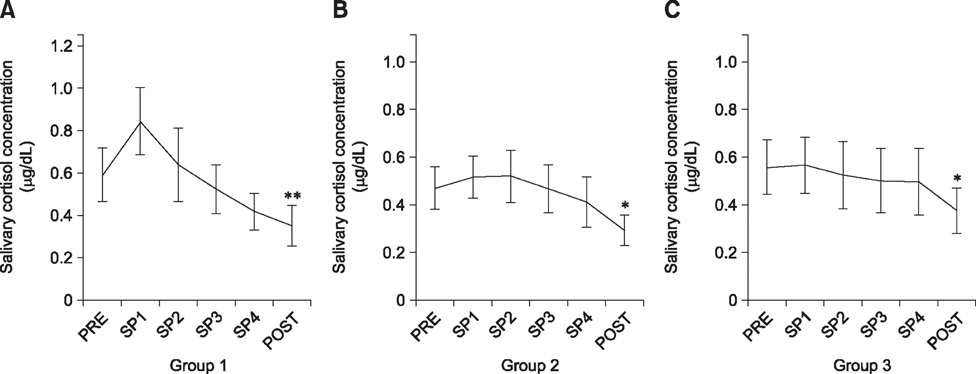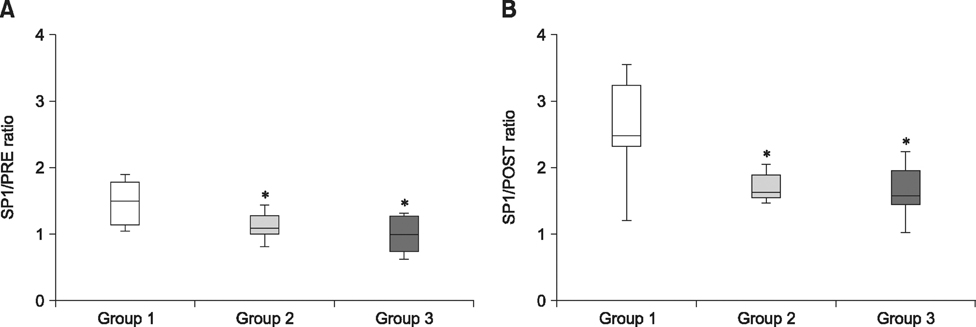J Vet Sci.
2016 Jun;17(2):153-158. 10.4142/jvs.2016.17.2.153.
Evaluation of effects of olfactory and auditory stimulation on separation anxiety by salivary cortisol measurement in dogs
- Affiliations
-
- 1Department of Zoo and Wildlife Medicine, College of Veterinary Medicine, Seoul National University, Seoul 08826, Korea. nsshin@snu.ac.kr
- KMID: 2413164
- DOI: http://doi.org/10.4142/jvs.2016.17.2.153
Abstract
- Separation anxiety (SA) is a serious behavioral problem in dogs. In this study, salivary cortisol was studied to determine if the owner's odor or voice could reduce SA in dogs. Twenty-eight dogs with SA were divided into three groups: group 1 (control), group 2 (with owner's clothes during the separation period; SP) and group 3 (a recording of the owner's voice was played during SP). The dog's saliva was collected after the owner and their dog were in the experimental room for 5 min (PRE). The dog was then separated from the owner for 20 min and saliva collected four times at intervals of 5 min (SP1-4). Finally, the owner was allowed back into the room to calm the dog for 5 min, after which saliva was collected (POST). Evaluation of salivary cortisol concentrations by ELISA revealed that the ratios of SP1 concentration to PRE or POST concentrations were significantly higher in group 1 than in group 2 or 3. Additionally, the concentrations of SP1-PRE and SP1-POST among groups differed significantly. These findings indicate that the owner's odor or voice may be helpful to managing stress in dogs with SA.
Keyword
MeSH Terms
Figure
Reference
-
1. Appleby D, Pluijmakers J. Separation anxiety in dogs: the function of homeostasis in its development and treatment. Clin Tech Small Anim Pract. 2004; 19:205–215.
Article2. Bamberger M, Houpt KA. Signalment factors, comorbidity, and trends in behavior diagnoses in dogs: 1,644 cases (1991-2001). J Am Vet Med Assoc. 2006; 229:1591–1601.
Article3. Beerda B, Schilder MBH, Bernadina W, Van Hooff JARAM, De Vries HW, Mol JA. Chronic stress in dogs subjected to social and spatial restriction II. Hormonal and immunological responses. Physiol Behav. 1999; 66:243–254.
Article4. Beerda B, Schilder MBH, Janssen NSCRM, Mol JA. The use of saliva cortisol, urinary cortisol, and catecholamine measurements for a noninvasive assessment of stress responses in dogs. Horm Behav. 1996; 30:272–279.
Article5. Beerda B, Schilder MBH, van Hooff JARAM, de Vries HW, Mol JA. Behavioural and hormonal indicators of enduring environmental stress in dogs. Anim Welf. 2000; 9:49–62.6. Beerda B, Schilder MBH, van Hooff JARAM, de Vries HW, Mol JA. Behavioural, saliva cortisol and heart rate responses to different types of stimuli in dogs. Appl Anim Behav Sci. 1998; 58:365–381.
Article7. Bergamasco L, Osella MC, Savarino P, Larosa G, Ozella L, Manassero M, Badino P, Odore R, Barbero R, Re G. Heart rate variability and saliva cortisol assessment in shelter dog: human–animal interaction effects. Appl Anim Behav Sci. 2010; 125:56–68.
Article8. Bodnariu A. Indicators of stress and stress assessment in dogs. Lucr Stiint Med Vet. 2008; 41:20–26.9. Coppola CL, Grandin T, Enns RM. Human interaction and cortisol: can human contact reduce stress for shelter dogs? Physiol Behav. 2006; 87:537–541.
Article10. Denenberg S, Landsberg G, Horwitz D, Seksel K. A comparison of cases referred to behaviorists in three different countries. In : Mills D, Levine E, Landsberg G, Horwits D, Duxbury M, Mertens P, Meyer K, Huntley LR, Reich M, Willard J, editors. Current Issues and Research in Veterinary Behavioral Medicine: Papers Presented at the Fifth Veterinary Behavior Meeting. West Lafayette: Purdue University Press;2005. p. 56–62.11. Dreschel NA, Granger DA. Methods of collection for salivary cortisol measurement in dogs. Horm Behav. 2009; 55:163–168.
Article12. Flannigan G, Dodman NH. Risk factors and behaviors associated with separation anxiety in dogs. J Am Vet Med Assoc. 2001; 219:460–466.
Article13. Haverbeke A, Diederich C, Depiereux E, Giffroy JM. Cortisol and behavioral responses of working dogs to environmental challenges. Physiol Behav. 2008; 93:59–67.
Article14. Hekman JP, Karas AZ, Dreschel NA. Salivary cortisol concentrations and behavior in a population of healthy dogs hospitalized for elective procedures. Appl Anim Behav Sci. 2012; 141:149–157.
Article15. King JN, Overall KL, Appleby D, Simpson BS, Beata C, Chaurand CJP, Heath SE, Ross C, Weiss AB, Muller G, Bataille BG, Paris T, Pageat P, Brovedani F, Garden C, Petit S. Results of a follow-up investigation to a clinical trial testing the efficacy of clomipramine in the treatment of separation anxiety in dogs. Appl Anim Behav Sci. 2004; 89:233–242.
Article16. Kobelt AJ, Hemsworth PH, Barnett JL, Butler KL. Sources of sampling variation in saliva cortisol in dogs. Res Vet Sci. 2003; 75:157–161.
Article17. Landsberg G, Hunthausen W, Ackerman L. Behavior Problems of the Dog and Cat. 3th ed. St Louis: Saunders Elsevier;2013. p. 201–210.18. Palestrini C, Minero M, Cannas S, Rossi E, Frank D. Video analysis of dogs with separation-related behaviors. Appl Anim Behav Sci. 2010; 124:61–67.
Article19. Parthasarathy V, Crowell-Davis SL. Relationship between attachment to owners and separation anxiety in pet dogs (Canis lupus familiaris). J Vet Behav. 2006; 1:109–120.
Article20. Schwartz S. Separation anxiety syndrome in dogs and cats. J Am Vet Med Assoc. 2003; 222:1526–1532.
Article21. Simpson BS, Landsberg GM, Reisner IR, Ciribassi JJ, Horwitz D, Houpt KA, Kroll TL, Luescher A, Moffat KS, Douglass G, Robertson-Plouch C, Veenhuizen MF, Zimmerman A, Clark TP. Effects of reconcile (fluoxetine) chewable tablets plus behavior management for canine separation anxiety. Vet Ther. 2007; 8:18–31.22. Takeuchi Y, Houpt KA, Scarlett JM. Evaluation of treatments for separation anxiety in dogs. J Am Vet Med Assoc. 2000; 217:342–345.
Article23. Vincent IC, Michell AR. Comparison of cortisol concentrations in saliva and plasma of dogs. Res Vet Sci. 1992; 53:342–345.
Article
- Full Text Links
- Actions
-
Cited
- CITED
-
- Close
- Share
- Similar articles
-
- An Exploratory Study on Occupational Stress and Anxiety Through Salivary Cortisol and Self-Report Scale in Korean Nurses on Shift and Regular Work
- Evaluation of Salivary Cortisol and Anxiety Levels in Myofascial Pain Dysfunction Syndrome
- Effects of Auricular Acupressure Therapy on Psychological Factors, Sleep Quality, and Salivary Cortisol Levels in South Korean Older Adults in the Community: A Single-blind, Randomized Controlled Trial
- Effects of alprazolam on capture stress-related serum cortisol responses in Korean raccoon dogs (Nyctereutes procyonoides koreensis)
- Clinical and Technical Aspects in Free Cortisol Measurement




